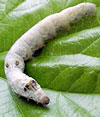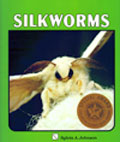
![]()
Search the Journey to Forever website – click HERE
|
Journey to Forever: Make a donation |
Navigation
Contact usTo Keith Addison Handmade Projects |
Silkworms in a shoebox
Rearing silkworms in the classroom or at home
There are about a million known species of insects, and entomologists estimate that many millions more have not yet been identified, but of all these species, only one has been domesticated by man: Bombyx mori, the  silk moth.
silk moth.
After nearly 5,000 years of selective breeding, silk moths have lost the ability to fly and cannot survive without humans.
 Many of us wouldn't survive without the moths either -- many, many people around the world depend on the silk moth for their livelihood, from peasant farmers who grow the mulberry leaves the silkworms eat and poor rural women who rear the moths and produce the precious cocoons, to the fashion boutiques in the world capitals that sell the luxury silk garments and fabrics.
Many of us wouldn't survive without the moths either -- many, many people around the world depend on the silk moth for their livelihood, from peasant farmers who grow the mulberry leaves the silkworms eat and poor rural women who rear the moths and produce the precious cocoons, to the fashion boutiques in the world capitals that sell the luxury silk garments and fabrics.

A hundred years ago the silk moth brought hundreds of thousands of peasant women in south China a new freedom they'd never had before when a world silk boom swelled demand, bringing prosperity to the women who raised the worms and spun the silk in their homes, and job opportunities for women workers in new local silk factories. (See Sisters of silk -- Hong Kong's Chinese Amahs.) A woman silk worker could earn enough to support a family of five.
Today silkworm raising is bringing independence to peasant women in Cambodia via the efforts of the Khemara NGO, the "voice of women in Cambodia", which has revived traditional Cambodian silk growing, weaving and dyeing in its work to empower women at the grass-roots level.

Khemara's rural development program: this Cambodian village loom weaves silk for home use
By the time a silkworm starts weaving its cocoon it weighs 10,000 times more than when it hatched from its egg as a tiny creature less than two millimetres long, all from eating mulberry leaves.
Any other insect that attacked such a useful, multi-purpose plant as a mulberry like that would be a farmer's deadly enemy, the target of poison sprays and biological controls like killer wasps or bacterial diseases. But we treasure the silk moth, and it rewards us well -- today's silk industry is worth about $2 billion a year worldwide.
Annual world production is estimated at about 100,000 tons -- more than 600 billion cocoons. A single cocoon contains anything between 0.5 and 1.5 kilometres of thread.
The Chinese discovered the secret of silk about 2640 BC, and kept it a secret -- for nearly 3,000 years all silk came from China. But the secret escaped when sericulture spread to India in the 2nd century AD, and to Japan a few centuries later.
In the 6th century AD two Persian monks visited China and smuggled a few silk moths back to the West hidden in bamboo canes. These were the basis of the European silk industry for the next 1,400 years.
Today Italy is the major European silk producer -- the French industry never recovered from a plague in the 19th century which wiped out the worms. About 70% of world production still comes from China, and another 12% from India, with Japan, Russia, Vietnam and Brazil accounting for most of the balance.
India produces several different kinds of silk, not all of them from the silk moth. These are "Wild Silks" such as Tussar, feeding on oak leaves, Eri on the castor-oil plant leaves and Muga on polyanthus leaves. Each of these produces different kinds of yarns. See About Silk from J.J. Exporters Ltd for more information.

Natural and "wild" silk from India
Wild African silkmoths are being domesticated to generate valuable income for African farmers. Asian countries are no longer producing enough raw silk to satisfy demand but African farmers could reap the benefits of this market opportunity by supplementing their income with silk production, or sericulture. ICIPE (International Centre of Insect Physiology and Ecology), based in Nairobi, is providing farmers in Kenya and Uganda with the opportunity to produce valuable tussar silk from indigenous African silkmoths. The moths feed on Acacia trees rather than mulberries.
http://www.new-agri.co.uk/99-3/focuson/focuson7.html
Related projects
Sisters of silk -- Hong Kong's Chinese Amahs
Mulberry trees
Kids' crazes
Resources
The Khemara NGO initiated the Cambodian Women's movement and supports women's empowerment in Cambodia. Read how the group is reviving Cambodian silk growing and weaving, and traditional natural dyeing methods. Well illustrated: from mulberry to silk worm, harvesting the silk, Cambodian Ikat dyeing, the loom for the weaving, Ikat weaving.

Silk moths at a Khemara village project
http://www.cambodia.org/clubs/
khemara/cover.htm
Silkworm Raisers' Customs -- a description of traditional cottage craft silk raising in Zhejiang and Jiangsu provinces in China. Legends, folklore, taboos. "When a couple get married, the girl's parents will send the couple two young mulberries, two round shallow baskets of silkworms and silk clothes and bedding as a dowry. They hope that the bride will bring brisk business."
http://www.chinavista.com/experience/silkworm/silkworm.html
Information for K-12 teachers about raising silkworms in their classrooms. Comprehensive resource: teacher resources, eggs and equipment, raising silkworms, history, schedule, display case, silk thread and cloth, science questions. Entire website can be downloaded as text (1.7 MB) and printed out. Overview of the silkworm cycle with pictures, extensive links to more silkworms sites on the Internet. Microsoft Word document:
http://www.suekayton.com/Silkworms/Silkworms.doc
Silkworm Rearing -- Center for Insect Science Education Outreach at the University of Arizona. Lesson plans, information sheets, rearing sheets, bibliography.
http://insected.arizona.edu/silkrear.htm
Rearing The Domestic Silk Moth -- Sericulum provides full instructions and supplies for schools, includes the company's Silkworm Cocoon Discovery Kit with cocoons, equipment and study guide; eggs, specimen moths, anatomical diagrams, literature.

How-to book from Sericulum
http://www.sericulum.com/
Mulberry Farms in California supplies silkworms and silkworm supplies -- live silkworms, silkworm eggs, baby silkworms, preserved mulberry feed for raising silkworms all year long. They also supply silkworms as food for pet reptiles. Email info@mulberryfarms.com
http://www.mulberryfarms.com/